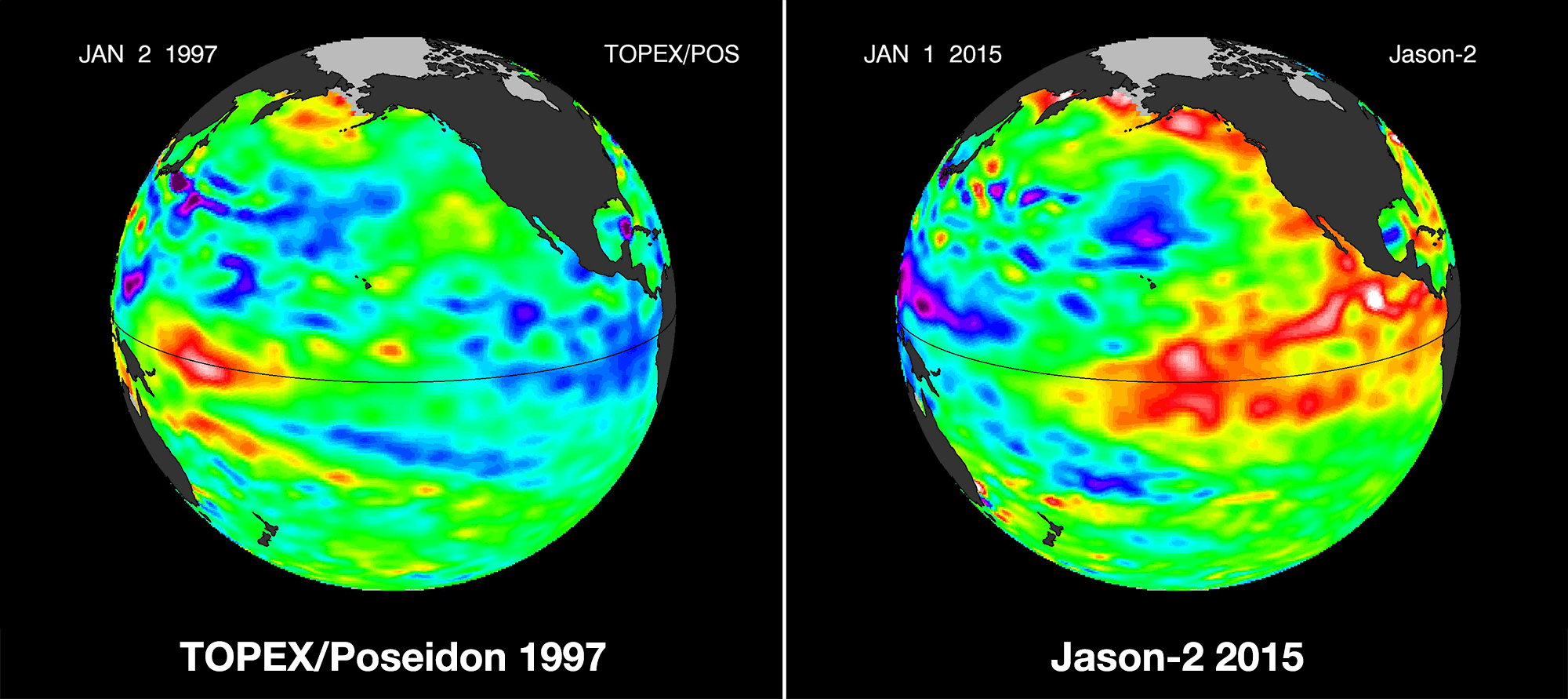Ask NASA Climate | September 10, 2015, 22:42 PDT
El Niño can do some serious trash talking

El Niño: 1997 vs. 2015 side by side comparisons of Pacific Ocean sea surface height (SSH). More here.
“The water is soooo warm!”
That sentence keeps popping out of Angelenos' mouths. It’s practically impossible to stick a toe into the California Pacific Ocean without making some sort of immediate involuntary exclamation regarding the water temperature. And the water has been unbelievably warm lately. The surf zone is full of swimmers frolicking in the waves. And even my cold-water averse puppy is now joyously prancing on his skinny little legs through the surf.
But along with the in-and-out, back-and-forth of the waves, my own moments of beach-ly delight also have an up-and-down quality. See, every time I stroll across the sand, I notice trash. Some pieces of trash are large items that people have obviously left on purpose, too neglectful to carry them away. Other pieces are small bits of plastic: a torn shred of wrapper, a crumb of rubber band that accidentally got away. I can’t help myself from noticing it. And I can’t help myself from picking it up, every piece I see, walking it over to a trash can, and throwing it in. When I see a piece of beach trash, nothing in me will allow me to walk past it. I can’t not pick it up.
A few days ago, as the sun was setting and most of the people had gone, I saw a seagull with a water bottle in its mouth. It reminded me of my puppy, who loves to chew a water bottle. He’ll grab it and run gleefully in circles until he drops and gets busy on the cap. If I don’t take it off him, he will start to swallow the chewed pieces. The gull was doing the same thing, playing with the bottle near the edge of the water, pecking instead of chewing, but otherwise in the same bouncy mood. I chased him down, took the water bottle off him and recycled it.
So I left the beach with mixed feelings. I’m just one person on one beach for one day. What about the rest of the beaches? What about the other days? Who will pick up the plastic there?
I come to this blog with similar mixed feelings. The warm waves feel wonderful, but I know it’s warm because of El Niño, the global climate event that starts on the eastern side of the Pacific Ocean all the way from California down to Peru. El Niño is complicated.1 Will it bring much-needed rain to the parched southwestern region of the United States and relieve us from this ongoing drought? Will it be too much rain all at one time? Will it cause flooding and landslides?
Even now the warmer waters on our side of the Pacific are causing many species that thrive in cooler waters to struggle while warmer water species are temporarily moving in. Sure, it’s interesting to SCUBA dive and see tropical fish, but the sea lions who depend on cooler waters are hating it big time.
Up-and-down, back-and-forth, in-and-out.
I figured you wouldn’t want to read yet another depressing piece about how much we’re trashing our planet. So, in searching for something less dismal, I went to talk with Bill Patzert and Josh Willis, unarguably the world’s leading experts on El Niño, to see what they had to say about our current El Niño conditions (other than the fact that they’re making a swim more pleasant and bringing lots of pink clouds to our Southern California sunsets).As I walked in, the two NASA oceanographers were in the middle of a discussion about the impact of El Niño rains on the amount of ocean trash. “Oh perfect,” I thought. “So I’m going with a trash-themed blog. Game on, Oscar the Grouch, game on.”
When I told them about my inability to walk past trash at the beach, Patzert said, “Our beaches have been exceptionally clean for over a decade now because we haven’t had a strong El Niño. As soon as those rains come, any trash hibernating in our storm sewers or on our streets will get flushed into the L.A. River and onto SoCal beaches.”
Woohoo, trash!! Too bad Oscar isn’t a sea monster. He’d be elated.
Find out more about El Niño and the NASA instruments that study the phenomenon from space here.
Thank you for your comments.
Laura
1Some scientific info about El Niño: Most of the time, under normal ocean conditions, trade winds blow from the east side of the Pacific to the west side. These winds push surface water towards the Western Pacific near Asia and Australia where the warm water piles up. This Western Pacific Warm Pool contains some of the warmest ocean waters on the planet. Every decade or so, the trade winds soften and all that warm water that normally stays on the western side of the Pacific, sloshes back towards the east and we get a phenomenon known as El Niño. Since the Pacific Ocean takes up about half of planet Earth, it has the potential to affect global weather patterns. A strong El Niño can bring warm moist conditions to the West Coasts of the Americas, while leaving Australia and Southeast Asia unusually dry. So far, the 2015-2016 El Niño is shaping up to be an exceptionally strong one.

